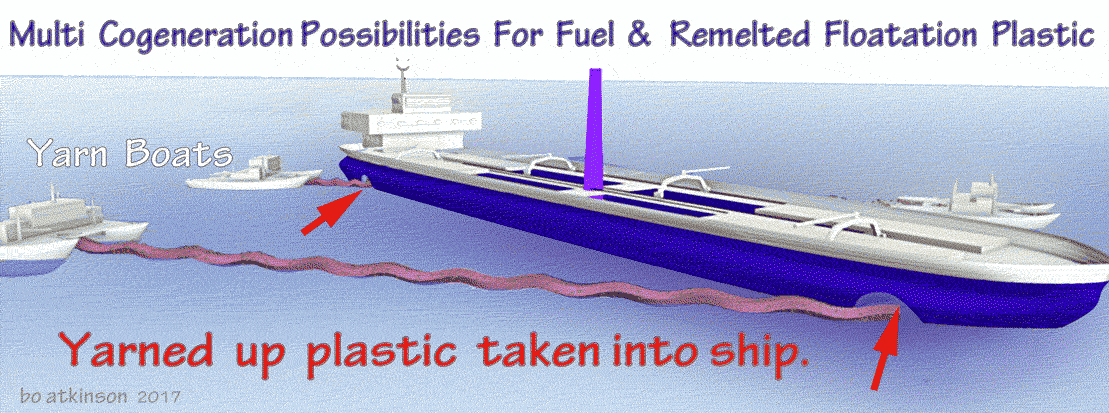
2017 updates: Here are continued collections of day dreamed ideas, for ocean clean up. Question: How may salvaged gyre plastic be well consolidated, for good uses? How may recycling itself provide energy for operational fuel and for making recycled building materials, (to store for other applications or markets). Could floatation materials be made to expand and to accelerate ocean clean up operations? This webpage tests my unrelenting imagination, by use of 3D models, (or artgineering}. A larger vessel seems practical to process the salvaged plastic, with smaller boats to yarn in the loose plastic from the waters.

I was intrigued by the concept of a large ship to dry out the salvaged plastic efficiently and cleanly burn it, while solidifying surplus melt, into other useful forms. I welcome discussion on these concepts. I imagine this cogeneration system, fitting together many practical details. Artgineering tests my ideals, based on my long life of small scale prototyping.
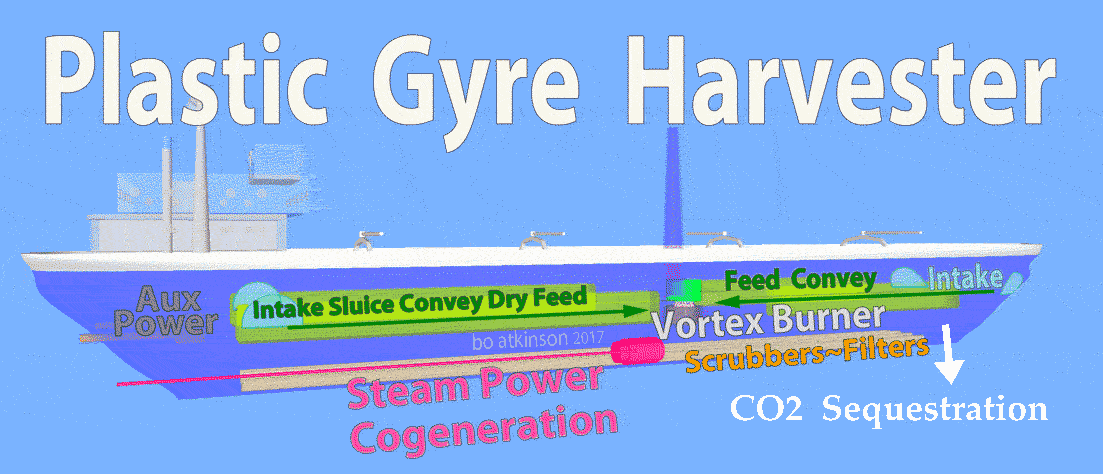
From ScienceDirect: A case for deep-ocean CO2 sequestration
".... In addition, an important added value benefit may be derived from deep ocean sequestration. A CO2 hydrate industrial crystallization desalination/disposal process is particularly applicable to oceanic islands and coastal areas adjacent to narrow continental shelves where abyssal depths can be reached by the dense, dissolved CO2-rich water gravity mass flows composed of processed water rejected from the desalination process."
In the 1980s i experimented with solid fuel burning in a regenerative, vortex burner. Here is my older vortex burner page.
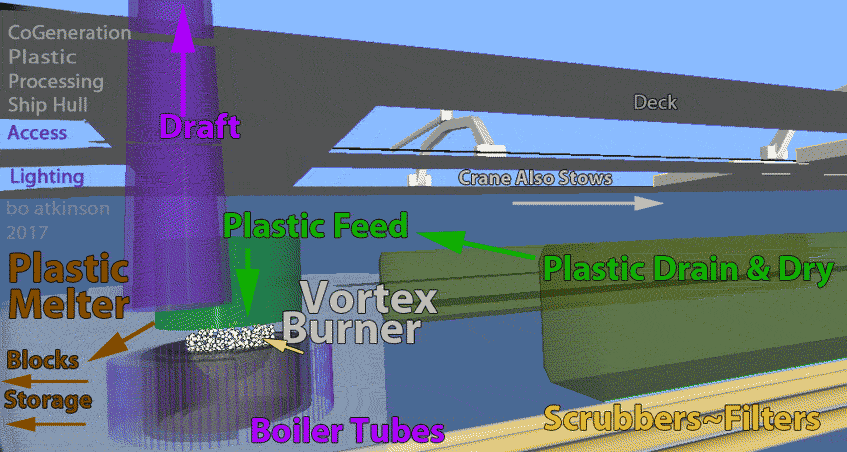
Originally i felt that large bails could densify the mass sufficiently to store up commercially valuable plastic masses. An island sized bail collection, of salvaged plastic, had seemed an adequate volume, to inspire continued dream studies. I began casually talking about tensile or binding strengths needed to build a plastic island of considerable size. A buildable multi-purpose floatation resource was the basis of a credible promise. My ideas are generally modeled and shelved, on the"shared internet of purposes".
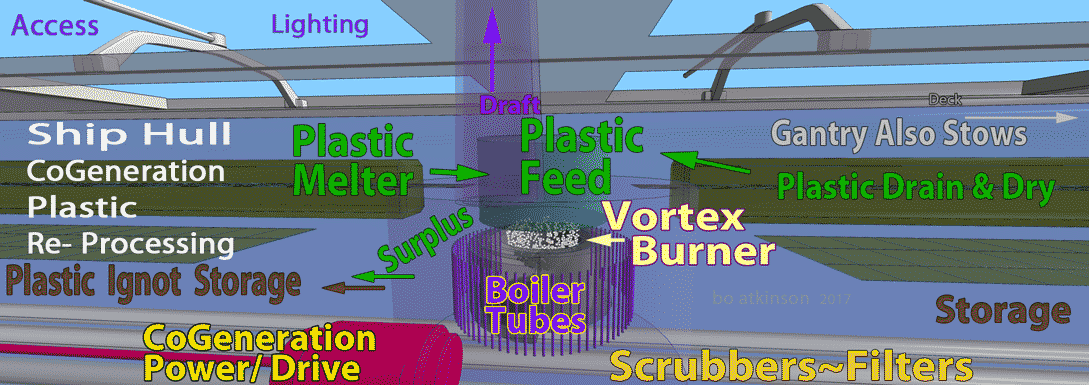
I believe that a large ship could be harmoniously laid out, for a very clean process activity. Since the plastic is already pre washed by the ocean. The decks could be well fitted for sky lighting the protected work areas below. An ideally developed architecture could motivate crews to live and work on board. As there is so much agreement to restore the ocean and to save the planet. Now, if only lovable careers could be offered to people who want to devote their lives, to adventuresome improvements of our world. Next below are some initial ideals for smaller boats to yarn salvaged plastic.
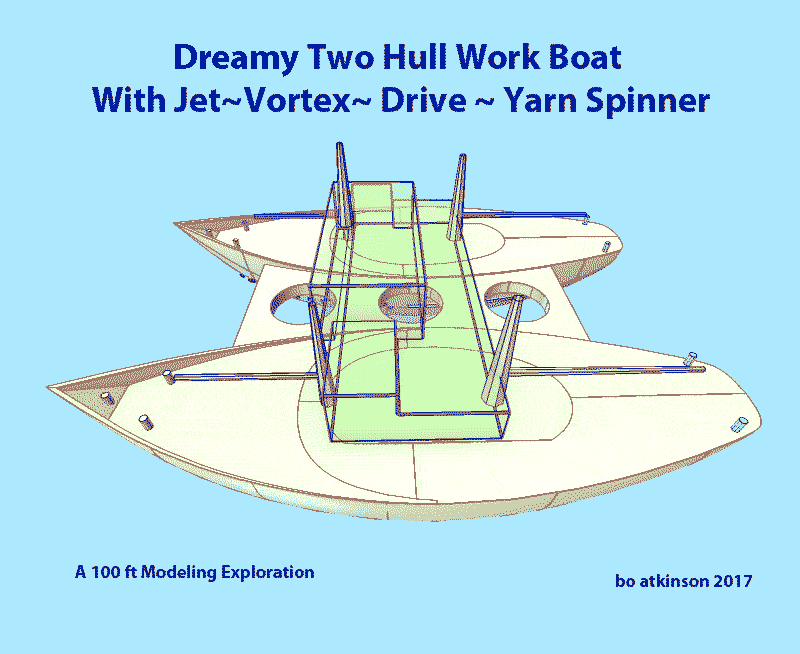
How on earth may we ever handle the plastic-karma? Obscene industrial standards pollute the oceans without any solutions and authorities blame the little consumers. Yes, common people have personal responsibility for all their personal actions. The bigger response is due, from those who reaped the greater profit from this waste stream. Causes and effects are piling up and i pity the fate of the profiteers who ignore the win-win causes and effects. The ocean offers opportunities.

I enjoy challenging solutions for "salvaging-the-ocean-washed plastic", to reduce pollution hazards. To me this feels like a liberating adventure for many kinds of applicable skills or assets. I love inventive exploration.

What if compacting trash could produce be yarned? This means consolidation of loose plastic pieces into a more solidified form. Creature protection from loose plastics is an initial challenge . Waste removal is the heavy task. A vortical-conveyor-dewatering-compaction concept, could could b prototyped, with a little collaboration. A spinning action during collection might sufficiently yarn the loose plastic to convey it towards the processing ship. .

What struck me, was that yarn is simply spun into coils which bind the whole! So that we might find just the right spinning tools to accomplish the daunting task. Below, my model of a two hull boat explores a funnel effect of parallel hulls, as well as water-turbines to spin the plastic in a propulsive vortex, as the boat moves forward. A yarned mass may be trailed behind, for a separate, continued binding operation. Finally to be harvested, by the best proven process. Some initial thoughts follow.
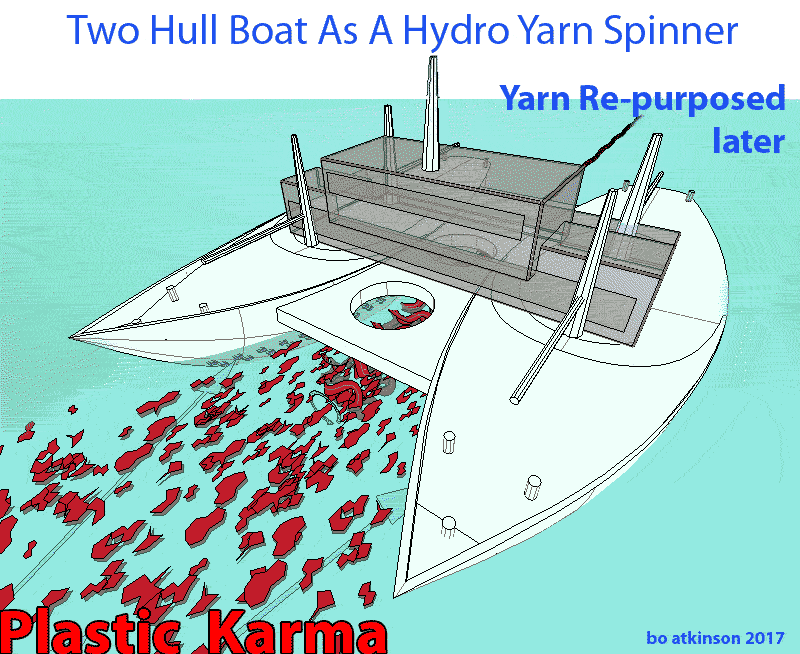
The front of two hulls take in ocean water and force it out through through jets aiming towards the aft sections. (Further hull concepts could develope with prototyping. It is possible i will experiment with this concept at a very scale.) This turbulence imaginatively spins the trash into some sort of constraint . High speed jets of water are proven to cut even hard materials, so that nozzles might be arranged to slice pieces longitudinally, w2hile with the same motion spin like yarn. The same expenditure of energy would propel the boat forward. Scaled down experiments may explore possibilities, to determine further experimental directions and developments!
Preventing innocent creatures from entrapment in gyres and from such powerful jets, is where work-study-volunteers might come in. Where a culture of caring might expand support opportunities today. Dedicated people could live on such a boat, for a period of time and monitor the process. Including the rescue of stray creatures, returning them to a cleaner ocean, as well. At least provide added balance to the madly destructive human activities of today.
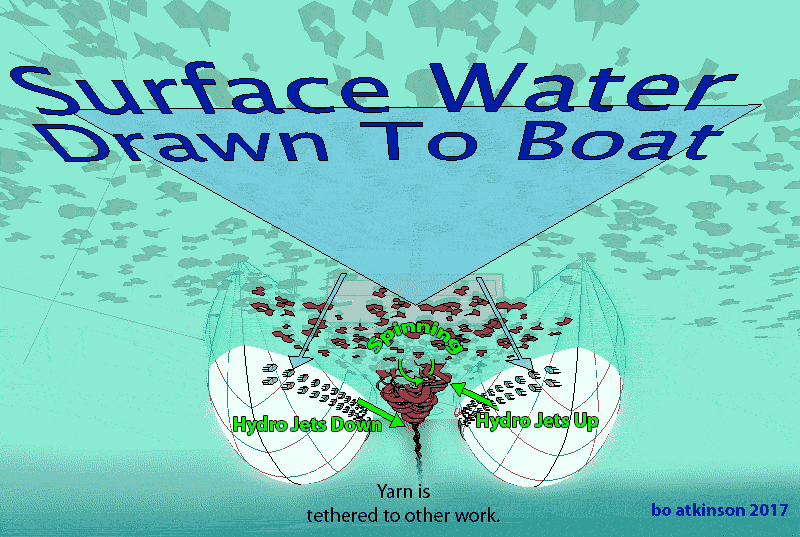
Much lower costing feasibility testing should be carried out first. To imagine and test experiments, to see how this might work. My art work here is only preliminary imagination and a call for constructive discussion. Please write or Skype. Discussions will spur on further efforts, to rig up actual experimentation. I have many pressure washer nozzles, but need a 10-20 horsepower pump and other fittings. I have a suitable pond, next to my workshop and already spend my time on harmonious, humanitarian exploration, (through investigative prototyping).
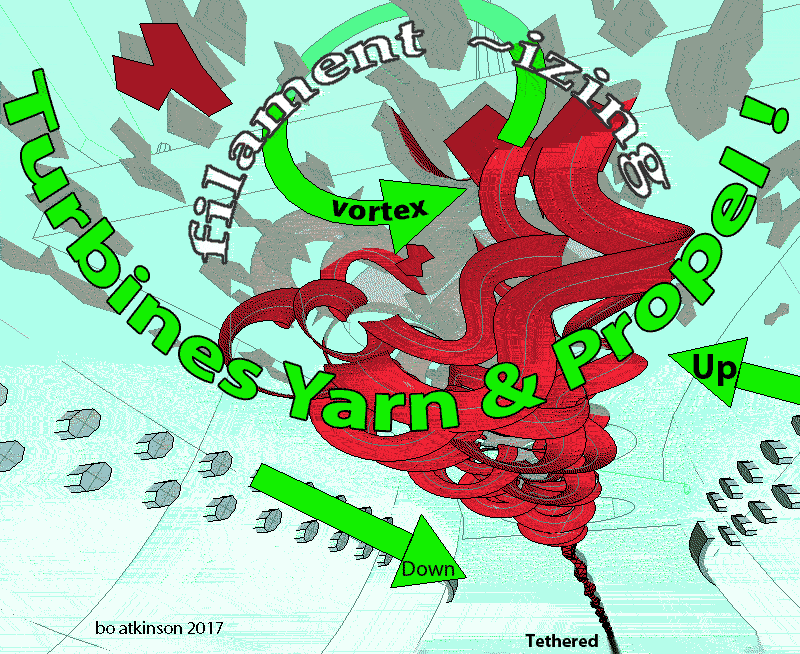
I expect that filament- izing might prove difficult to achieve, but the protoyping is well worth exploring. Let us see what is discoverable! I will continue my modeling of these ideas. Use the "Reload Button" on your internet browser, to see the latest updates. Or help me, ha, ha, with better web code or best of all with the integral experiment to filament- ize + to yarn + to propel and to clean up the oceans!
Preliminary, physical protoyping ideas is my limited presentation here. This is based on my 4 decades of low tech prototyping (and small contractor and artgineering occupation). Following is the original content of the gyre page, dating back to 2008.
~~~~~~~~~~~~~~~~~~
Plastic-Karma? Industrial seed of self destruction? vs A Floatation Resource?
Picture above from NOAA. Ocean currents distribute many tons of accumulated plastic trash, because it floats. It seems as though there are too many tons for routine clean up. The loosely floating plastic may prove too awkwardly troublesome to recycle as a carbon resource. Indifferent powers that be do trash earth's gift of water and ecosystems, (by omitting to observe industrial self immolation, now evident). At least, consider cleanup solutions. Laws fail to solve littering issues. Who will start the clean up? Following are some mere concepts by Bo Atkinson, Maine USA.
First, the baler concept pictured above would pull flotsam into mechanical rollers which "roll" the garbage in order to make a cylindrical bale for subsequent recycling. Harpoon-like devices could "lasso" floating garbage clusters and reel them in for a twisting compaction to make bales. A "spaghetti fork" also is lowered into the garbage to provide more traction. After twirling the trash in sync with the rollers, the fork is retracted upwards to release the bale. It is expected that some cohesion will result from the trash itself, while additional baling filaments or wires are also likely required.
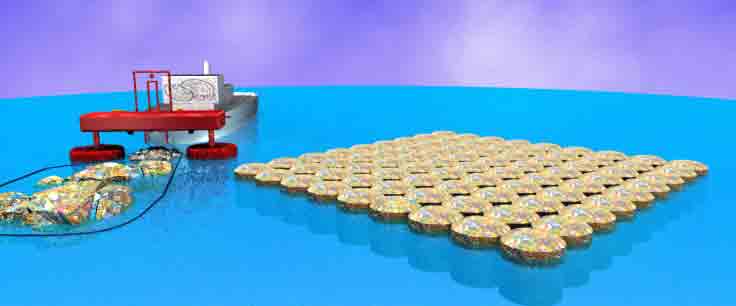
If a floating island could be built with the bales, could such an island economically withstand storms or tsunamis? Would trash consolidation remain substantially firm in order for life forms to attach and offer more of the environmental stabilizing factors of ecosystems? Does loose trash shed off ecosystems? Would stabilized trash allow healthy growth? I've read that plastic does harbor anaerobic bacteria (bad guys), but aerobic bacteria (good guys) do flourish on anaerobic bacteria, so could eco-harmony develop? If stainability proved possible, then at least one re-use of the material exists. What purpose could such an island serve? I would think a good preliminary use to consider is to establish a base for researching long-term plastic-waste research. However, the artificial flotation property of plastic may yet serve a more important, useful service. Modeling an atoll would seems fun to me.
Consider the vast amount of plastic that does in fact float. Note the location in relatively calmer areas of the oceans. If massive floatation was wanted, here it has already been delivered and awaits intelligent assembly. Sea life awaits it's rendering into a less harmful format. Collecting floating bales may help jump start a better feasibility study, to further evaluate bale collection for intelligent use. At least, baling will reduce the maiming caused by loosely floating trash.
Continued baling research might offer means to prevent wild life molestation. Floating islands as a base for further research, also brings to mind aqua culture research. Are ocean trash-gyres distant from coveted fishing turfs? If so, then aqua culture research may benefit from a new operational base. Could bales be formed into floating, artificial atolls?
Many pictures of the amazing gyre phenomenon can be seen on the www. Estimates of size say it is larger than small countries in expanse, (surface area).
"Trash vortex"
"Great Pacific Garbage Patch"
Gyres: A recycling force of it's own design? Nature: A die-hard, self-corrective system but would it include humanity's self destruction? Are we that close to the tipping point of self destruction through destruction of ocean life? From the web, next, is an illustration of some of the larger ocean gyres, around the world. Gyres offer us some help to capture the trash, but will any power that be do something positive? I wonder.
Would a working solution encourage people to dump more aggressively in the oceans? It is said much of this trash comes from land disposal which carelessly blows into the sea. Are so many human lives disparaged by leadership examples in our world, that they care less? Is there no hope for inspiring all humans to prosper, rather than planning an unproductive despair, for the masses? I hope generally and want to work on attainable solutions. I will experiment with more design models such as an artificial, floating island, for a gyre.
Here is information about my structural abilities.
Here is a list of my many structural ideas.
Public comments / ideas: I am intrigued by this real problem and invite people to think about this idea with me. E m a i l- boa1@pivot.net Here is one which addresses specific tools. Other comments received so far did not focus on tools. Apparently some interests are considering "harvesting" plastic for fuel or by products on large scales.
I'm not very familiar with the specifics referred to below, but share it all the same--
Hi Bo,
Your concept of baling plastic trash intrigues me.
I do brush clearing for fire safety and have been interested in baling brush for others to chip for some time with limited success. For brush clearing with a small mono cable skyline I have used hollow braided rope (non rotational) to receive smaller 'chokers' made from 450 lb knot strength baling twine by inserting the twine a few inches upstream. This connection prevents rotation which is a potential problem. The chokers are cut with a simple blade on a block to drop the load where desired.
You commented "It is expected that some cohesion will result from the trash itself, while additional baling filaments or wires are also likely required."
Do you think that it might be practical to sort some of the trash into filaments which would in turn be wound into twine and then two strand rope?
The rope would be (chain?) stitched to form nets or pads to collect smaller pieces when dragged through the water.
To collect smaller pieces, a hollow mono cable dyneema fiber rope (Samson Blue is typical with 1/7 the weight of wire rope with equivalent strength) a few thousand feet long on a capstan winch could be used to make a continuous loop containing these small collector nets. Of course the hollow rope has to be slack at the point of insertion, but this could be done before deployment or even during deployment at some additional cost.
By circling, the trawler could collect smaller plastic pieces. Once aboard the trawler, additional bundling could take place and perhaps the bundles could be grouped into islands as you conceptualized.
I have gotten many ideas from your work online. Thank you for sharing.
Paul Miller
Georgetown, California